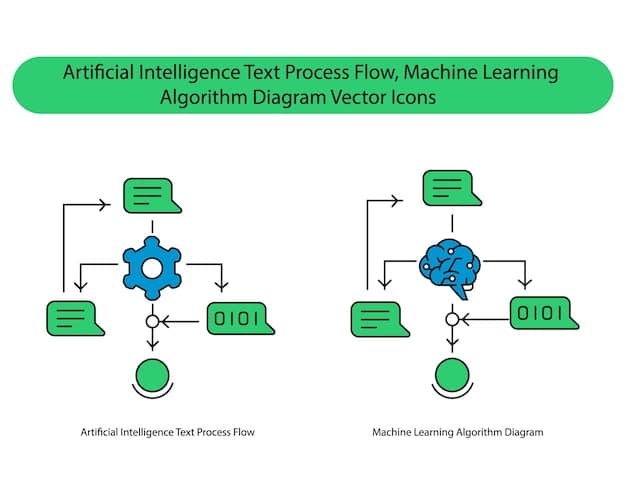AI Chatbots: Smart 2025 Investment for US Small Businesses?

AI-powered chatbots offer US small businesses in 2025 24/7 customer support, lead generation, and cost savings, but require careful planning, training, and integration to ensure they deliver a worthwhile return on investment.
Are AI-powered chatbots worth the investment for US small businesses in 2025? As technology evolves, these digital assistants offer compelling benefits, but understanding their potential and limitations is crucial for making informed decisions.
Understanding AI Chatbots for Small Businesses
AI chatbots have evolved from simple automated responders to sophisticated tools capable of understanding context, learning from interactions, and providing personalized experiences. For small businesses in the US, this transformation offers both opportunities and challenges.
Let’s explore what makes AI chatbots tick and how they can potentially reshape customer interactions and business operations.
What are AI Chatbots?
AI chatbots are computer programs powered by artificial intelligence that simulate human conversation. They can interact with users through text or voice, providing information, answering questions, and even completing transactions.
These chatbots leverage natural language processing (NLP) and machine learning (ML) to understand user intent and generate relevant responses.
Key Features of AI Chatbots
- Natural Language Processing (NLP): Enables chatbots to understand and interpret human language.
- Machine Learning (ML): Allows chatbots to learn from interactions and improve their responses over time.
- Integration Capabilities: Chatbots can be integrated with various platforms, including websites, social media, and messaging apps.
- Personalization: Some AI chatbots can personalize interactions based on user data and preferences.
The appeal of AI chatbots lies in their ability to automate tasks, provide instant support, and improve customer engagement, potentially saving businesses time and resources.
The Benefits of AI Chatbots for US Small Businesses in 2025
In 2025, the benefits of AI chatbots for US small businesses extend beyond simple customer service. From cost savings to lead generation, these tools can significantly impact various aspects of business operations.
Let’s delve into the specific advantages that AI chatbots offer and how they can be leveraged for maximum impact.

24/7 Customer Support
One of the primary benefits of AI chatbots is their availability. They can provide instant support to customers around the clock, addressing queries and resolving issues even outside of regular business hours.
This continuous availability can significantly improve customer satisfaction and loyalty.
Cost Savings
By automating customer service tasks, AI chatbots can reduce the need for human agents, leading to significant cost savings. They can handle a large volume of inquiries simultaneously, freeing up human agents to focus on more complex issues.
- Reduced labor costs
- Improved efficiency
- Lower training expenses
Lead Generation and Sales
AI chatbots can also play a crucial role in lead generation and sales. They can engage website visitors, qualify leads, and even guide them through the sales process.
By providing personalized recommendations and answering questions, chatbots can increase conversion rates and drive revenue.
Potential Challenges and Considerations
While AI chatbots offer numerous benefits, it’s important to acknowledge the potential challenges and considerations that US small businesses need to address before investing in this technology.
From initial costs to ongoing maintenance, understanding these factors is crucial for ensuring a successful implementation.
Initial Investment and Setup
Implementing AI chatbots requires an initial investment in software, hardware, and training. Small businesses need to carefully evaluate their budget and choose a solution that aligns with their needs and resources.
Additionally, setting up and integrating the chatbot with existing systems can be complex and time-consuming.

Training and Maintenance
AI chatbots require ongoing training and maintenance to ensure they provide accurate and relevant responses. This involves regularly updating the chatbot’s knowledge base, monitoring its performance, and addressing any issues that arise.
Small businesses need to allocate resources for these tasks to ensure the chatbot remains effective.
Data Privacy and Security
AI chatbots collect and process user data, raising concerns about data privacy and security. Small businesses need to comply with relevant regulations, such as GDPR and CCPA, and implement measures to protect user data from unauthorized access.
- Ensure compliance with data privacy regulations
- Implement data encryption and security protocols
- Obtain user consent for data collection
Addressing these challenges requires careful planning, investment, and ongoing commitment. However, the potential rewards make it a worthwhile endeavor for many small businesses.
Choosing the Right AI Chatbot Solution
Selecting the right AI chatbot solution is a critical decision for US small businesses. With a wide range of options available, it’s important to carefully evaluate different factors to ensure the chosen solution aligns with your specific needs and goals.
Let’s explore some key considerations for choosing the right AI chatbot solution.
Identify Your Business Needs
Before evaluating different solutions, it’s essential to clearly identify your business needs and goals. What specific tasks do you want the chatbot to automate? What customer service issues do you want to address? What are your budget constraints?
Answering these questions will help you narrow down your options and choose a solution that effectively meets your needs.
Evaluate Features and Capabilities
Different AI chatbot solutions offer different features and capabilities. Some are designed for simple customer service tasks, while others offer more advanced features like lead generation and sales automation.
Carefully evaluate the features and capabilities of each solution to ensure they align with your business needs.
Consider Integration Capabilities
The ability to integrate with existing systems, such as your website, CRM, and messaging apps, is crucial for maximizing the value of your AI chatbot solution.
- Ensure seamless integration with your website
- Connect with your CRM system for lead management
- Integrate with popular messaging apps
Choose a solution that offers seamless integration with your existing infrastructure.
Best Practices for Implementing AI Chatbots
Implementing AI chatbots effectively requires more than just choosing the right solution. It also involves following best practices to ensure a smooth transition and maximize the potential benefits.
Let’s explore some essential best practices for implementing AI chatbots in your US small business.
Start with a Clear Strategy
Before launching an AI chatbot, develop a clear strategy that outlines your goals, target audience, and key performance indicators (KPIs). What do you want to achieve with the chatbot? How will you measure its success?
A well-defined strategy will guide your implementation efforts and ensure you stay on track.
Train Your Chatbot Thoroughly
The effectiveness of an AI chatbot depends heavily on the quality of its training. Provide your chatbot with a comprehensive knowledge base, including FAQs, product information, and customer service scripts.
Regularly update the chatbot’s training data to ensure it stays relevant and accurate.
Monitor and Optimize Performance
Continuously monitor the performance of your AI chatbot to identify areas for improvement. Track key metrics like customer satisfaction, response time, and conversion rates.
- Track customer satisfaction scores
- Monitor response time and accuracy
- Analyze conversion rates
Use this data to optimize the chatbot’s performance and improve the user experience.
The Future of AI Chatbots in Small Business
The future of AI chatbots in small business is promising. As AI technology continues to advance, chatbots are becoming more sophisticated, personalized, and capable of handling complex tasks.
Let’s explore some emerging trends and future possibilities for AI chatbots in the small business landscape.
Enhanced Personalization
AI chatbots are becoming increasingly capable of providing personalized experiences based on user data and preferences. They can tailor interactions to individual customers, offering personalized recommendations and support.
This enhanced personalization can significantly improve customer satisfaction and loyalty.
Improved Natural Language Understanding
Advances in NLP are enabling chatbots to understand human language more accurately and contextually. They can better interpret user intent, even when expressed in complex or ambiguous language.
Integration with Emerging Technologies
AI chatbots are increasingly being integrated with other emerging technologies, such as virtual reality (VR) and augmented reality (AR). This integration can create new and engaging customer experiences.
In conclusion, AI-powered chatbots offer a compelling investment opportunity for US small businesses in 2025, but success hinges on careful planning, implementation, and ongoing optimization.
| Key Point | Brief Description |
|---|---|
| 🕒 24/7 Support | Offers round-the-clock customer assistance, boosting satisfaction. |
| 💰 Cost Savings | Reduces labor costs by automating customer service tasks. |
| 📈 Lead Generation | Engages visitors and qualifies leads, increasing conversion rates. |
| ⚙️ Integration | Integrates with existing systems for seamless operations. |
Frequently Asked Questions
▼
AI chatbots offer 24/7 customer support, cost savings through automation, lead generation, and improved customer engagement, enhancing overall business efficiency and satisfaction.
▼
The cost varies depending on the complexity of the solution, ranging from free or low-cost basic chatbots to more advanced, feature-rich solutions that require a significant investment.
▼
Challenges include initial investment costs, the need for ongoing training and maintenance, ensuring data privacy and security, and the potential for chatbots to misunderstand or provide inaccurate responses.
▼
Identify your business needs, evaluate features and capabilities, consider integration with your existing systems, and choose a solution that aligns with your budget and technical expertise.
▼
Train your chatbot thoroughly with a comprehensive knowledge base, regularly update its training data, monitor its performance, and optimize its responses based on user feedback and analytics.
Conclusion
For US small businesses in 2025, AI-powered chatbots represent a strategic investment, offering cost-effective customer support and enhanced lead generation. However, success depends on carefully assessing needs, selecting the right solution, and continuously optimizing performance to maximize benefits and ensure a positive return on investment.





